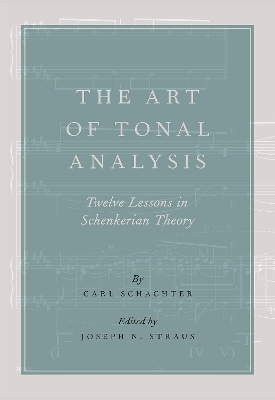
The Art of Tonal Analysis
Oxford University Press Inc (Verlag)
978-0-19-090917-8 (ISBN)
In Fall 2012, Schachter taught a doctoral seminar at the CUNY Graduate Center in which he talked about the music and the musical issues that have concerned him most deeply; the course was in essence a summation of his extensive and renowned teaching. In The Art of Tonal Analysis, winner of the Society for Music Theory's 2017 Citation of Special Merit, music theorist Joseph Straus presents edited transcripts of those lectures. Accompanied by abundant music examples, including analytical examples transcribed from the classroom blackboard, Straus's own visualizations of material that Schachter presented aurally at the piano, and Schachter's own extended Schenkerian graphs and sketches, this book offers a vivid account of Schachter's masterful pedagogy and his deep insight into the central works of the tonal canon. In making the lectures of one of the world's most extraordinary musicians and musical thinkers available to a wide audience, The Art of Tonal Analysis is an invaluable resource for students and scholars of music.
Carl Schachter is an extraordinary musician and musical thinker, and the world's leading practitioner of Schenkerian theory and analysis. He has written extensively on the masterworks of the tonal common practice and on the analytical delights and challenges that they present. Although his articles and books have been broadly influential, and are seen by many as models of musical insight and lucid prose, perhaps his greatest impact has been felt in the classroom. At the Mannes College of Music, the Juilliard School of Music, Queens College and the Graduate Center of the City University of New York, and at special pedagogical events around the world, he has taught generations of musical performers, composers, historians, and theorists. Joseph N. Straus has published widely on topics in modernist music and post-tonal music theory. He is a former President of the Society for Music Theory.
Prelude Editor's Preface
Lesson One: Linear Progressions and Neighbor Notes
Lesson Two: J.S. Bach, Menuet in C minor from French Suite No. 2 and Chopin, Etude, Op. 10, No. 12
Lesson Three: Chopin, G#-minor and E-major Preludes from Op. 28
Lesson Four: Schubert, Sonata in Bb major, Scherzo
Lesson Five: Handel, Suite No. 8 for Harpsichord, Courante
Lesson Six: J.S. Bach, Gavotte en Rondeaux from Violin Partita No. 3 in E major
Lesson Seven: Mozart, Sonata for Violin and Piano, K. 481, Adagio
Lesson Eight: Beethoven, String Quartet, Op. 18, No. 6, first movement
Lesson Nin: Beethoven, String Quartet, Op. 18, No. 6, fourth movement
("La Malinconia")
Lesson Ten: Rhythm, Hypermeter, and Phrase
Lesson Eleven: Haydn, Symphony No. 99, Adagio
Lesson Twelve: Beethoven, Piano Sonata, Op. 53 ("Waldstein"), first movement
Postlude. Q and A
Glossary
Works Cited
Index
| Erscheinungsdatum | 28.09.2018 |
|---|---|
| Zusatzinfo | 192 musical examples |
| Verlagsort | New York |
| Sprache | englisch |
| Maße | 178 x 249 mm |
| Gewicht | 499 g |
| Themenwelt | Kunst / Musik / Theater ► Musik ► Klassik / Oper / Musical |
| Kunst / Musik / Theater ► Musik ► Musiktheorie / Musiklehre | |
| ISBN-10 | 0-19-090917-X / 019090917X |
| ISBN-13 | 978-0-19-090917-8 / 9780190909178 |
| Zustand | Neuware |
| Haben Sie eine Frage zum Produkt? |
aus dem Bereich


